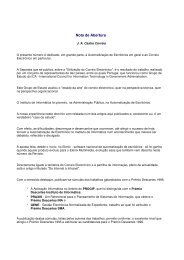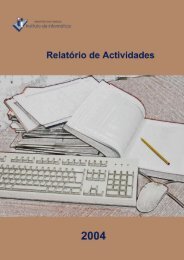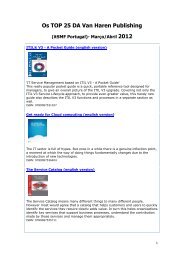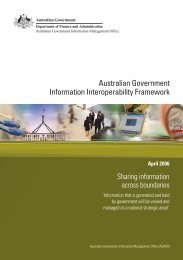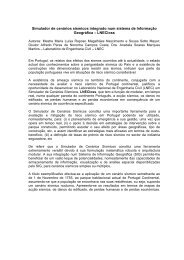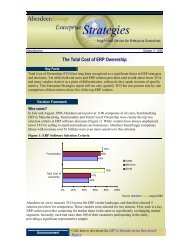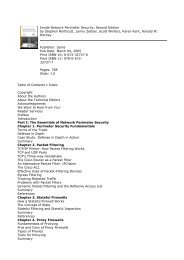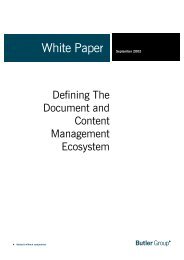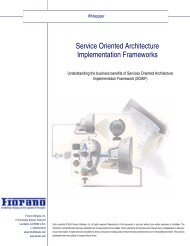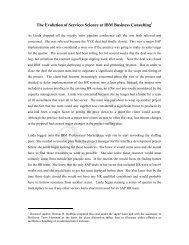OECD Peer Review of E-Government in Denmark - ePractice.eu
OECD Peer Review of E-Government in Denmark - ePractice.eu
OECD Peer Review of E-Government in Denmark - ePractice.eu
Create successful ePaper yourself
Turn your PDF publications into a flip-book with our unique Google optimized e-Paper software.
had developed extensive practical knowledge <strong>in</strong> the area, and also identified barriers that needed to be<br />
overcome if government was to use digital signatures on a wide scale. The two biggest problems<br />
identified were <strong>in</strong>adequate knowledge <strong>of</strong> the use <strong>of</strong> digital signatures, and technical difficulties <strong>in</strong><br />
<strong>in</strong>stall<strong>in</strong>g and configur<strong>in</strong>g digital signature solutions.<br />
In 2003, the digital signature project advanced significantly when government decided to<br />
distribute signatures to citizens, bus<strong>in</strong>esses and public organisations free <strong>of</strong> charge.<br />
The Danish Knowledge Strategy<br />
Introduced <strong>in</strong> 2003, this strategy aims to develop a Danish “knowledge system” that ranks among<br />
the best <strong>in</strong> the world <strong>in</strong> terms <strong>of</strong> its efficiency and competitiveness. While primarily focused on the<br />
Danish knowledge system (the public and private sector knowledge <strong>in</strong>stitutions and companies which<br />
produce, attract, dissem<strong>in</strong>ate and apply research-based and other advanced knowledge) the strategy<br />
recognises the fundamental relationship between public sector use <strong>of</strong> ICT and the future success <strong>of</strong> the<br />
knowledge system.<br />
The strategy notes the major efforts made throughout the 1990s and <strong>in</strong>to the 2000s to ensure that<br />
e-government provided Danes with easier access to the public sector, and stresses the importance <strong>of</strong><br />
maximiz<strong>in</strong>g the benefits <strong>of</strong> this <strong>in</strong> terms <strong>of</strong> achiev<strong>in</strong>g both better government and stronger economic<br />
growth. It then notes the e-government challenge <strong>of</strong> develop<strong>in</strong>g and us<strong>in</strong>g ICT to support better<br />
collaboration and exchange <strong>of</strong> data across traditional organisational boundaries, both with<strong>in</strong> the public<br />
sector and between the public and private sectors. The strategy identifies or cross-references e-<br />
government <strong>in</strong>itiatives <strong>in</strong> the areas <strong>of</strong> IT security, digital signatures and the development <strong>of</strong> common<br />
XML schemas for data exchange. It also states that the <strong>Government</strong>’s future ICT and<br />
telecommunications policy action plan will focus on mak<strong>in</strong>g progress <strong>in</strong> areas where State government<br />
can “usefully be viewed as one unit <strong>in</strong> relation to IT usage” such as development <strong>of</strong> ICT architecture<br />
and common networks, benchmark<strong>in</strong>g, and s<strong>of</strong>tware strategy.<br />
First steps towards e-government<br />
Get go<strong>in</strong>g with e-<strong>Government</strong><br />
In 1997, the first explicit e-government step was taken under the leadership <strong>of</strong> the M<strong>in</strong>istry <strong>of</strong><br />
Research and Information Technology. Called Get go<strong>in</strong>g with e-<strong>Government</strong>, the report was an<br />
attempt to put e-government on the policy agenda and improve the implementation <strong>of</strong> e-government<br />
by emphasis<strong>in</strong>g benefits such as efficiency ga<strong>in</strong>s, rationalisation, and delivery <strong>of</strong> better public services<br />
to citizens and bus<strong>in</strong>esses. The report aimed to guide and <strong>in</strong>spire public sector organisations that had<br />
plans to implement e-government, especially <strong>in</strong> relation to electronic document management systems<br />
(EDMS). It gave examples <strong>of</strong> how e-government visions and goals should be formulated, as well as<br />
how management should behave.<br />
The report was complemented by another report called E-government – Requirements for<br />
Systems, which conta<strong>in</strong>ed advice to government organisations on specify<strong>in</strong>g requirements for EDMS.<br />
The report identified common core needs, issues and check po<strong>in</strong>ts that should be identified and<br />
addressed with<strong>in</strong> each organisation. The ma<strong>in</strong> recommendation was for organisations (m<strong>in</strong>istries <strong>in</strong><br />
particular) to buy one system for the whole organisation, rather than allow<strong>in</strong>g each part <strong>of</strong> the<br />
organisation (i.e. departments, agencies, etc.) to make its own choices.<br />
It also proposed development <strong>of</strong> a common strategy for electronic document management across<br />
the whole <strong>of</strong> State government. The proposal po<strong>in</strong>ted out that top management <strong>in</strong> organisations was<br />
180



